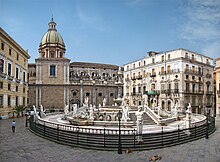Piazza Pretoria
 View of the square from Santa Caterina | |
| Location | Palermo, Sicily, Italy |
|---|---|
| Coordinates | 38°06′56″N 13°21′43″E / 38.11556°N 13.36194°E |
Piazza Pretoria, also known as square of Shame, is at the limits of the district of Kalsa, near the corner of Cassaro with Via Maqueda, just a few meters from the Quattro Canti, the exact center of the historic city of Palermo .
History
In 1573 the Senate of Palermo bought a fountain initially intended for the Palace of San Clemente in Florence, with the intention of placing it in the square.
To make way for the monumental achievement, designed for an open place, several homes were demolished and the fountain was re-adapted to the site with the addition of new parts. In 1581 the works of accommodation of the fountain on the square.
The large central fountain is the focal point for sixteen nude statues of nymphs, humans, mermaids and satyrs. Since eighteenth century in 1860, the fountain was considered the representation of corrupt municipalities, and Palermo nicknamed the square with the nudity of the statues, the Square of Shame (Piazza della vergogna.) This may have also been reflecting the prevailing influence of the Spanish Inquisition during that time.
Description
At the center of the square is the Fontana Pretoria (1554), by Francesco Camilliani, occupying a large part of the extension that strongly characterizes the Plan Praetorian. Three of the four sides are enclosed by buildings: the Praetorian Palace (the town hall) built in fourteenth century and renovated in nineteenth century, the Church of St. Catherine (end of sixteenth century), and two baronial palaces: Palazzo Bonocore and Palazzo Bordonaro. The fourth side of the square with a staircase descends to Via Maqueda.
